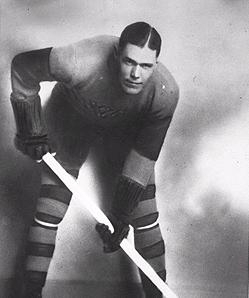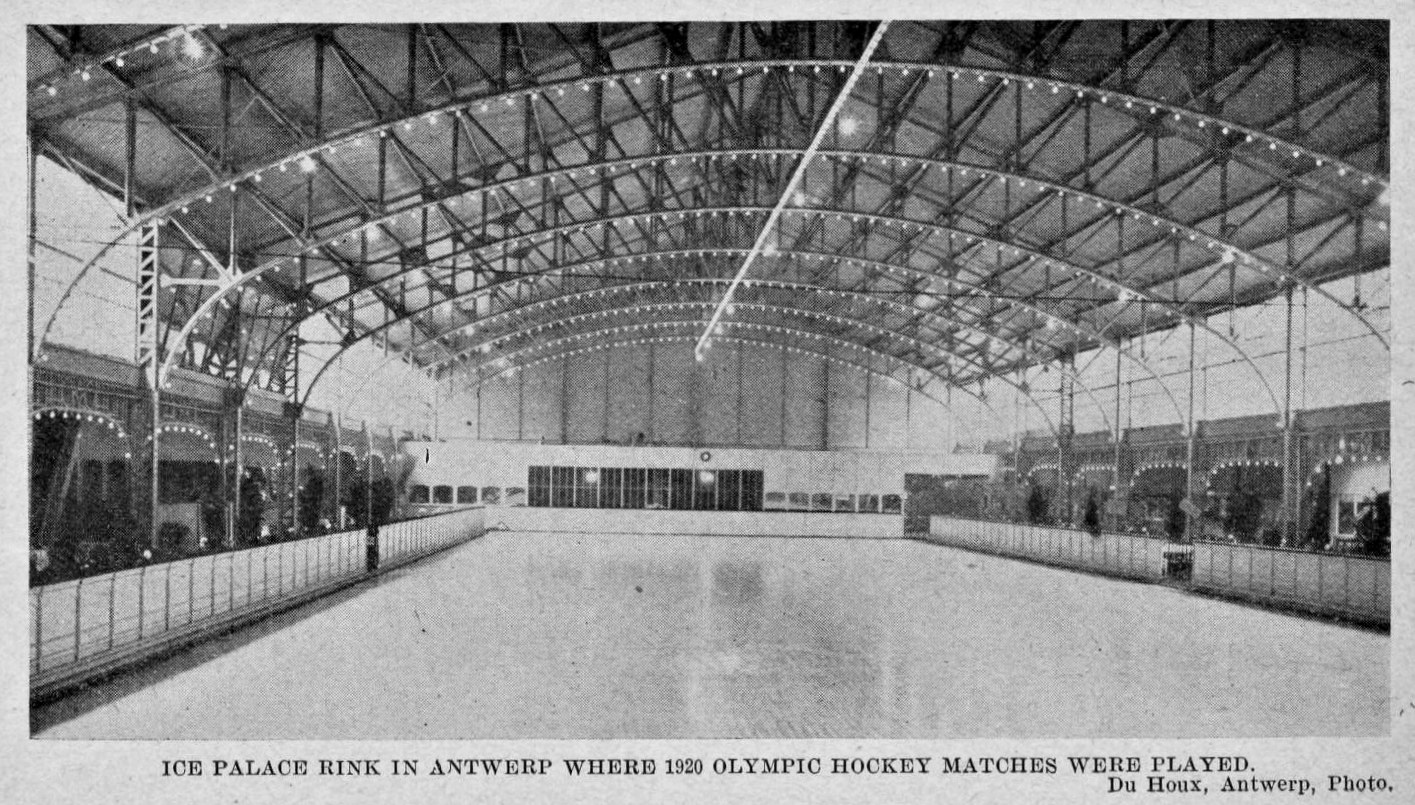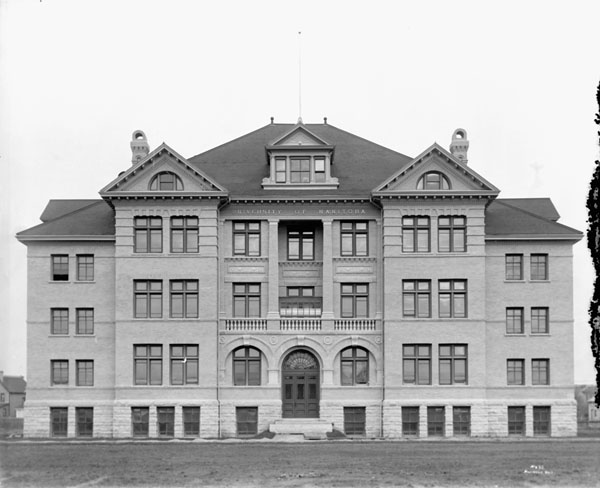|
Frank Fredrickson
Sigurdur Franklin Fredrickson (Sigurður Franklín Friðriksson; June 3, 1895 – May 28, 1979) was an Icelandic-Canadian ice hockey player and aviator. As a player and coach, he was significant to both the amateur and professional ice hockey as it evolved in North America in the early 20th century. Fredrickson's career was interrupted by military service during the First World War and prematurely ended by a knee injury in 1931. Fredrickson was the center for the Winnipeg Falcons, the Canadian team which won the Olympic gold medal in 1920. Fredrickson then joined the Victoria Aristocrats/Victoria Cougars and helped them win the Stanley Cup in 1925. On both occasions he was a teammate of fellow Icelandic-Canadian ice hockey star Haldor Halderson, making them the first players to win an Olympic gold medal and a Stanley Cup. Fredrickson became one of the pioneers of flight in Iceland when he arrived there in 1920 to fly for the countries first airline, ''Flugfélag Íslands''. T ... [...More Info...] [...Related Items...] OR: [Wikipedia] [Google] [Baidu] |
Ice Hockey At The 1920 Summer Olympics
Ice hockey was introduced to the Olympic Games at the 1920 Summer Olympics in Antwerp. The tournament also served as the first World Championships. The matches were played between April 23 and April 29, 1920. Canada, represented by the Winnipeg Falcons, won the gold medal. The silver went to the United States and Czechoslovakia took the bronze. Summary The organizing committee for the hockey matches included Paul Loicq, the captain of the Belgian team and a future president of the Ligue Internationale de Hockey sur Glace (LIHG). The games used the Canadian ice hockey rules, and the Bergvall system to determine medal winning teams. The Canadian Amateur Hockey Association (CAHA) chose the Winnipeg Falcons as the 1920 Allan Cup champions to represent the Canada men's national team, instead of forming a national all-star team on short notice.Podnieks, Andrew; Hockey Hall of Fame (2005), pp. 28–29 Canada's manager W. A. Hewitt, introduced the CAHA rules of play to the LIHG at t ... [...More Info...] [...Related Items...] OR: [Wikipedia] [Google] [Baidu] |
Icelandic Canadian
Icelandic Canadians are Canadian citizens of Icelandic ancestry or Iceland-born people who reside in Canada. Canada has the largest ethnic Icelandic population outside Iceland, with about 101,795 people of full or partial Icelandic descent as of the Canada 2016 Census. Many Icelandic Canadians are descendants of people who fled an eruption of the Icelandic volcano Askja in 1875. History The history between Icelanders and North America dates back approximately one thousand years. The first Europeans to reach North America were Icelandic Norsemen, who made at least one major effort at settlement in what is today Newfoundland (L'Anse aux Meadows) around 1009 AD. Snorri Þorfinnsson, the son of Þorfinnr Karlsefni and his wife Guðríður, is the first European known to have been born in the New World. In 1875, over 200 Icelanders immigrated to Manitoba establishing the New Iceland colony along the west shore of Lake Winnipeg in Manitoba, this is the first part of a larg ... [...More Info...] [...Related Items...] OR: [Wikipedia] [Google] [Baidu] |
196th Battalion (Western Universities), CEF
The 196th (Western Universities) Battalion, CEF was a numbered battalion in the Canadian Expeditionary Force during the First World War. Based in Winnipeg, Manitoba, the unit began recruiting during the winter of 1915/16 in universities throughout western Canada. After sailing to England in November 1916, the battalion was absorbed into the 19th Reserve Battalion on January 2, 1917, and its members were later dispersed across a number of different units. History Creation During the First World War, university staff and students from across western Canada wanted the opportunity to serve in the military while retaining their collective university identities. In December 1915, the University of Manitoba branch of the Canadian Officers' Training Corps sent two representatives to the University of British Columbia, University of Alberta, and University of Saskatchewan to lobby for these schools to agree on forming such a unit. This proposition was well received by these schools ... [...More Info...] [...Related Items...] OR: [Wikipedia] [Google] [Baidu] |
University Of Manitoba
The University of Manitoba (U of M, UManitoba, or UM) is a Canadian public research university in the province of Manitoba.''University of Manitoba Act'', C.C.S.M. c. U60. Retrieved on July 15, 2008 Founded in 1877, it is the first of . Both by total student enrolment and campus area, the U of M is the largest university in the province of Manitoba and the 17th-largest in all of Canada. Its main campus is located in the |
Kelvin High School
Kelvin High School is a public high school in Winnipeg, Manitoba, Canada. The school is located in the neighbourhood of River Heights. Kelvin teaches grades 9 to 12 and is part of the South District of the Winnipeg School Division. History The school was founded in 1912 as Kelvin Technical High School. The name was later changed to Kelvin High School, because of the increasingly academic focus of the school and the shift in the term "technical" in an educational sense. The school is named after the mathematical physicist and engineer William Thomson, 1st Baron Kelvin. Many Kelvin High School students fought in World War II. More than fifty were killed in battle. This inspired the 2005 documentary, ''The Boys of Kelvin High: Canadians in Bomber Command'', which was produced by Clifford Chadderton, a distinguished Canadian Forces infantry commander and Kelvin High School alumnus. The original 1912 school building was replaced by the current one in 1964. The French Immersi ... [...More Info...] [...Related Items...] OR: [Wikipedia] [Google] [Baidu] |
Icelandic Language
Icelandic (; is, íslenska, link=no ) is a North Germanic language spoken by about 314,000 people, the vast majority of whom live in Iceland, where it is the national language. Due to being a West Scandinavian language, it is most closely related to Faroese, western Norwegian dialects, and the extinct language, Norn. The language is more conservative than most other Germanic languages. While most of them have greatly reduced levels of inflection (particularly noun declension), Icelandic retains a four- case synthetic grammar (comparable to German, though considerably more conservative and synthetic) and is distinguished by a wide assortment of irregular declensions. Icelandic vocabulary is also deeply conservative, with the country's language regulator maintaining an active policy of coining terms based on older Icelandic words rather than directly taking in loanwords from other languages. Since the written language has not changed much, Icelandic speakers can read classic ... [...More Info...] [...Related Items...] OR: [Wikipedia] [Google] [Baidu] |
Winnipeg, Manitoba
Winnipeg () is the capital and largest city of the province of Manitoba in Canada. It is centred on the confluence of the Red and Assiniboine rivers, near the longitudinal centre of North America. , Winnipeg had a city population of 749,607 and a metropolitan population of 834,678, making it the sixth-largest city, and eighth-largest metropolitan area in Canada. The city is named after the nearby Lake Winnipeg; the name comes from the Western Cree words for "muddy water" - “winipīhk”. The region was a trading centre for Indigenous peoples long before the arrival of Europeans; it is the traditional territory of the Anishinabe (Ojibway), Ininew (Cree), Oji-Cree, Dene, and Dakota, and is the birthplace of the Métis Nation. French traders built the first fort on the site in 1738. A settlement was later founded by the Selkirk settlers of the Red River Colony in 1812, the nucleus of which was incorporated as the City of Winnipeg in 1873. Being far inland, the local c ... [...More Info...] [...Related Items...] OR: [Wikipedia] [Google] [Baidu] |
Tíminn
''Tíminn'' () was an Icelandic daily newspaper founded in 1917. It had close ties with the Icelandic Progressive Party but after years of financial difficulties, the party severed all ties with the paper in 1993. It merged with the newspaper ''Dagur'' in 1996, becoming ''Dagur-Tíminn''. Its last edition came out on 28 August 1996. References External linksPublished Issuesat the National and University Library of Iceland Landsbókasafn Íslands – Háskólabókasafn ( Icelandic: ; English: ''The National and University Library of Iceland'') is the national library of Iceland which also functions as the university library of the University of Iceland. The librar ... {{DEFAULTSORT:Timinn 1917 establishments in Iceland Publications established in 1917 Daily newspapers published in Iceland Defunct newspapers published in Iceland Mass media in Reykjavík Publications disestablished in 1996 ... [...More Info...] [...Related Items...] OR: [Wikipedia] [Google] [Baidu] |
Morgunblaðið
''Morgunblaðið'' (, ''The Morning Paper'') is an Icelandic newspaper. ''Morgunblaðið''s website, mbl.is, is the most popular website in Iceland. History ''Morgunblaðið'' was founded by Vilhjálmur Finsen and Ólafur Björnsson, brother of Iceland's first president. The first issue, only eight pages long, was published on 2 November 1913. On 25 February 1964, the paper first printed a caricature by Sigmúnd Jóhannsson which featured the first landings on Surtsey. He became a permanent cartoonist for ''Morgunblaðið'' in 1975 and worked there until October 2008. In a controversial decision, the owners of the paper decided in September 2009 to appoint Davíð Oddsson, a member of the Independence Party, Iceland's longest-serving Prime Minister and former Governor of the Central Bank, as one of the two editors of the paper. In May 2010, Helgi Sigurðsson was hired as the papers cartoonist. He became known for controversial drawings on topics such as immigration, refugee ... [...More Info...] [...Related Items...] OR: [Wikipedia] [Google] [Baidu] |
Haldor Halderson
Haldor Halderson (Halldór Halldórsson; January 7, 1898 – August 1, 1965) was an Icelandic-Canadian ice hockey player who competed in the 1920 Summer Olympics. Halderson was the right wing for the Winnipeg Falcons, the Canadian team which won the Olympic gold medal in 1920. Slim then joined the Victoria Aristocrats/Victoria Cougars and helped them win the Stanley Cup in 1925. On both occasions he was a teammate of fellow Icelandic-Canadian ice hockey star Frank Fredrickson, making them the first players to win an Olympic gold medal and a Stanley Cup. Playing career Halderson was born as Halldór Halldórsson in Winnipeg, Manitoba to Icelandic immigrants Halldór Stefán Halldórsson and Jórunn Chrisolina Jónsdóttir. Halderson never played organized junior or intermediate ice hockey in his hometown of Winnipeg, but sprang into fame overnight when he joined the senior ranks of the Winnipeg Ypres team of the Manitoba Hockey Association's military league in 1917–18. Hal ... [...More Info...] [...Related Items...] OR: [Wikipedia] [Google] [Baidu] |
First World War
World War I (28 July 1914 11 November 1918), often abbreviated as WWI, was one of the deadliest global conflicts in history. Belligerents included much of Europe, the Russian Empire, the United States, and the Ottoman Empire, with fighting occurring throughout Europe, the Middle East, Africa, the Pacific, and parts of Asia. An estimated 9 million soldiers were killed in combat, plus another 23 million wounded, while 5 million civilians died as a result of military action, hunger, and disease. Millions more died in genocides within the Ottoman Empire and in the 1918 influenza pandemic, which was exacerbated by the movement of combatants during the war. Prior to 1914, the European great powers were divided between the Triple Entente (comprising France, Russia, and Britain) and the Triple Alliance (containing Germany, Austria-Hungary, and Italy). Tensions in the Balkans came to a head on 28 June 1914, following the assassination of Archduke Franz Ferdina ... [...More Info...] [...Related Items...] OR: [Wikipedia] [Google] [Baidu] |







.png)